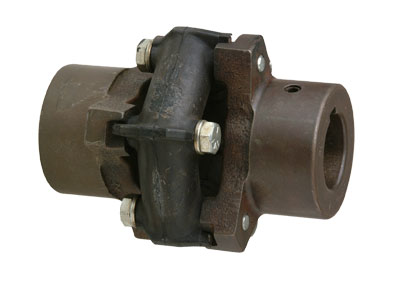Saga Coupling
Saga is a general purpose, torsionally soft coupling with high tolerance to all forms of misalignment. The design features hexagonal or octagonal rubber donut-shaped elements with metal inserts positioned at each apex during the vulcanization process. These metal inserts carry actual bolts which fix the element to tines on cast, cylindrical hubs. Embedded inserts also have tines which connect with mating surfaces on hubs so that axial bolts can be easily torqued during assembly without twisting the rubber beyond the limits of its elasticity. The rubber between each apex is pre-compressed, so it is much more durable to the stresses arising from the various forms of misalignment and torsional vibrations.
While the Saga coupling is normally associated with shaft-to-shaft applications, adaptations for flange and flywheel mountings can be made. In addition, a floating shaft version for use in lieu of a universal joint drive shaft with separate torsional coupling is available. Its elements can also be stacked in series for use in applications with extreme transient or permanent parallel misalignment, or where torsional dynamics demand an extremely soft element for proper damping and/or vibratory decoupling. The rubber’s stiffness of 60 as measured against Shore A by durometer, covers the majority of such situations.
- Elastomeric Pre-compression type coupling
- Lower torsional stiffness (than other rubber-in-compression couplings)
- No equal for high shock start/stop applications
- Applications include: piston-driven devices, compressors, violent pounding, or crushing units


